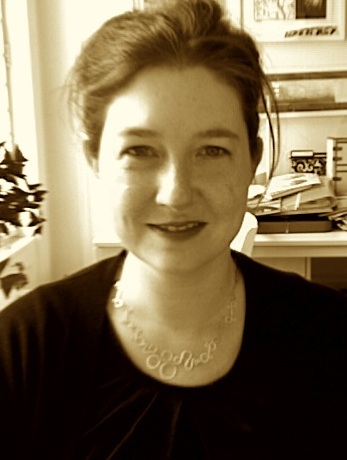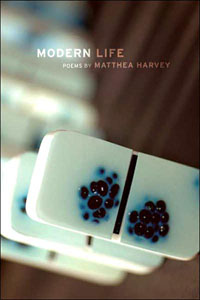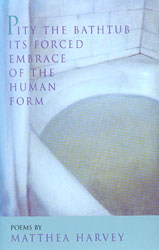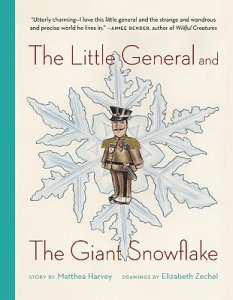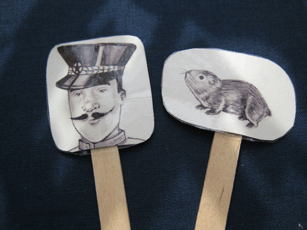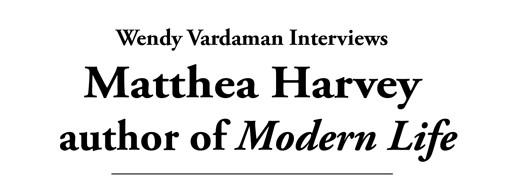
Animated poem read by the poet. Part of the Poetry Everywhere series, produced by the Poetry Foundation in association with docUWM at the University of Wisconsin-Milwaukee. Animation by Joseph Kraemer.
WV: You spent much of your childhood in Wisconsin, and your husband is, I think, from Fond du Lac, but there’s a kind of placeless/everyplace feel to your writing—it’s nowhere & everywhere at the same time. What sticks with you, if anything, from your time in Wisconsin?
MH: Yes, from age 8-18, I lived in Whitefish Bay, WI. I think my childhood in England is more apparent in the landscapes that are in my poems, at least “In Defense of Our Overgrown Garden” is based on our house in England, and some of the characters in that poem actually lived in my village (Marnhull). 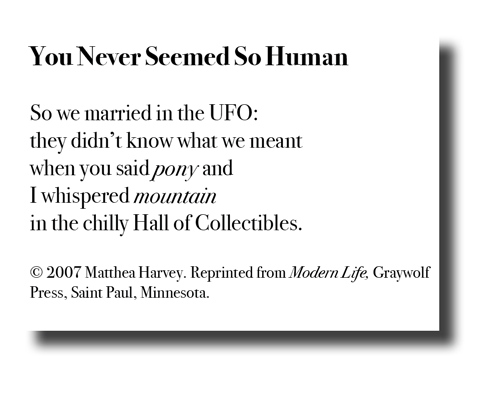 That may be the closest I’ve come to autobiography in a poem! One recent poem that has a distinct, if hidden, Milwaukee inspiration is the poem “You Never Seemed So Human,” a poem about two people getting married while they’re also being abducted by aliens. My husband, Rob (who is indeed from Fond du Lac) and I got married at Calatrava's Milwaukee Art Museum, and there really is a wonderful UFO feeling to that main hall space. You’ve made me realize that I haven’t really mined Milwaukee to the extent I might…stay tuned for poems including Winkie’s (a favorite dime store), rabbits dashing through sprinklers, and walking to school with wet hair and arriving with a headful of icicles.
That may be the closest I’ve come to autobiography in a poem! One recent poem that has a distinct, if hidden, Milwaukee inspiration is the poem “You Never Seemed So Human,” a poem about two people getting married while they’re also being abducted by aliens. My husband, Rob (who is indeed from Fond du Lac) and I got married at Calatrava's Milwaukee Art Museum, and there really is a wonderful UFO feeling to that main hall space. You’ve made me realize that I haven’t really mined Milwaukee to the extent I might…stay tuned for poems including Winkie’s (a favorite dime store), rabbits dashing through sprinklers, and walking to school with wet hair and arriving with a headful of icicles.
WV: I love the idea of you being biaccental (English/American), as well as bilingual (German/English). What effect has that had on your poetry? Was it difficult to move from England to Milwaukee?
MH: Is that a real term? If not, how lovely that you invented it. It’s really hard to know how my writing might be different if, for example, we had stayed in England, or moved back to Germany. All that doubling though may have affected my interest in hybrids, which really came out in Modern Life. I’ve also recently noticed that my children’s books sound more English than my poems. None of us wanted to move to Milwaukee particularly, so yes, it was hard.
WV: Do you still have family in Wisconsin? What, if any place, feels like home to you?
MH: My parents live in Bayside and a large percentage of Rob’s immediate and extended family lives in Wisconsin. My parents’ house feels like home, because it’s where we go for the holidays and because of all the traditions that we play out there (reciting poems in front of the Christmas tree, etc.), but New York felt like home to me the first time I came here.
WV: Is it advantageous for writers to live on the coasts, rather than in the Midwest?
MH: I don’t know. It probably depends on your temperament. I think it would be advantageous to live in a tree house or in an old train station, but that’s just me.
WV: Do you notice differences between the poetry of different American regions—for example, New England versus West Coast versus Midwest? Do we write “regionally” at all anymore, or has the internet, and greater mobility as a culture, erased those differences or drawn new ones?
MH: I think there are people who do write regionally, because that’s their subject matter—the way the sunset looks over a strip mall, memories of flirting at the ice rink, waking up to a deer at the window… Up to now, that hasn’t been mine. Until your earlier question, I didn’t think there was much place in my poems, but now I see a bit more of England in them. In recent years, since I moved to an apartment across from Prospect Park, I have written more poems about parks, but, mostly, as is my way, the parks are imaginary, and one poem was written before I moved here. Maybe I was park psychic. I don’t think that you can say by any stretch of the imagination that all Wisconsin or Brooklyn-based poets write in a particular way. Similar sensibilities can spring up next to each other in the flower bed, or across oceans.
WV: How did you become a poet? Did you think about doing other things?
MH: I wrote some poems and then I wrote some more. At an early age I remember telling my mother I was going to move to New York to become a writer and at night I would play in the pit orchestra for plays and musicals. That doesn’t sound too bad, does it?
WV: Have you ever felt uncomfortable identifying yourself as a poet? Did you have any poetic failures along the way? How does poetic success—the Kingsley Tufts Award or being a finalist for the 2008 National Book Critics Circle Award—alter your view of your work, or does it? How would you define poetic success?
MH: It’s an admittedly unusual thing to tell a person that writing poetry is your “profession.” Usually I just say “writer,” and maybe now that I write children’s books too, that’s accurate. I really didn’t know it was possible to be a poet until I got to Harvard, and then it just seemed like the most miraculous thing!
I have poetic failures all the time. Many failed poems. I try not to publish those, though some have slipped into each book, since I can’t always tell they’re failures until later… or I don’t want to admit that they are. I’m thrilled and amazed by the response to Modern Life, but it doesn’t change the fact that I’m already working on other projects. Poetic success is when you write a poem that makes you excited and bewildered and aglow.
WV: Have you done other work besides teaching? Do you advise young poets to get an MFA?
MH: Yes, right after grad school, I was the assistant to the chair of the graduate film program at NYU. After that, I worked in development at BOMB magazine for three years, and started doing some teaching on the side. I don’t think an MFA is a requirement, by any means, for being a writer, but it can be a great way to get exposed to new writers (dead and alive) and to have discussions you might not have alone at your desk, or with your cat.
WV: In addition to your recent and very successful Modern Life (2007), you’ve just published a children’s book, The Little General and the Giant Snowflake. What drew you to writing for children? Do you plan to do more work for kids? Is writing and publishing for children substantively different than writing poetry?
MH: I never planned to write a children’s book. The first one I wrote, Cecil the Pet Glacier, (which will be published by Schwartz and Wade) came out of my writing a silly bio for Volt. I said something like “She has a pet glacier called Cecil,” which in turn was inspired by having a friend tell me about having a pet snowball called Horsey when she was little. Then I started thinking about how fun it would be to write about a pet glacier! The Little General and the Giant Snowflake originated in a very vivid dream. I think the parameters of picture books and chapter books are a bit stricter than in poetry (I was a bit late in learning the rules), and it’s a hard market to crack. I’m still learning. It’s really thrilling to work with an illustrator (in the same way that having my poems set to music by Eric Moe has completely knocked my socks off)—your vision expands with the addition of someone else’s artwork/artistic vision. I am working on two other children’s books—Sod Story, a tale about a girl called Celia Greenstreet who lives on a turf farm and a leafcutter ant called Leon, as well as an alphabet book with Elizabeth Zechel, called These Birds Don’t Fly: An Alphabet of Absurd Birds.
WV: You seem like a globally gifted artist—interested in visual art and music as well as writing. You took the photograph on the cover of Modern Life, and I read that you studied the flute but don’t play any more. How do you make decisions about how to parcel out your artistic time? Is there other art besides poetry writing that you would like to be doing or plan to do?
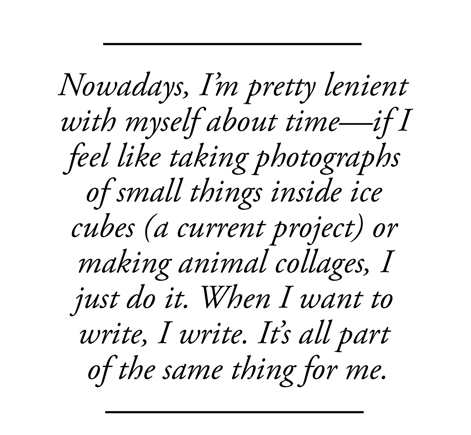 MH: I don’t know about globally gifted—only if it’s a miniature globe. Stopping playing the flute was part deciding to concentrate on poetry, part my cat’s hatred for the piccolo, and part having a hard time deciding to be an amateur player. At one point, I wanted to play professionally. Nowadays, I’m pretty lenient with myself about time—if I feel like taking photographs of small things inside ice cubes (a current project) or making animal collages, I just do it. When I want to write, I write. It’s all part of the same thing for me. I would love to collaborate on a graphic novel with an artist—I’m terrible at drawing but I really love that genre.
MH: I don’t know about globally gifted—only if it’s a miniature globe. Stopping playing the flute was part deciding to concentrate on poetry, part my cat’s hatred for the piccolo, and part having a hard time deciding to be an amateur player. At one point, I wanted to play professionally. Nowadays, I’m pretty lenient with myself about time—if I feel like taking photographs of small things inside ice cubes (a current project) or making animal collages, I just do it. When I want to write, I write. It’s all part of the same thing for me. I would love to collaborate on a graphic novel with an artist—I’m terrible at drawing but I really love that genre.
WV: Although you obviously pay attention to sound, your poetry is strikingly visual in nature; the imagery is vivid and often surreal. A poem like “Implications for Modern Life,” for example, reads as if it might be describing a fictional painting, or an alternate reality. Does visual art have more influence on your poetry than literature does? 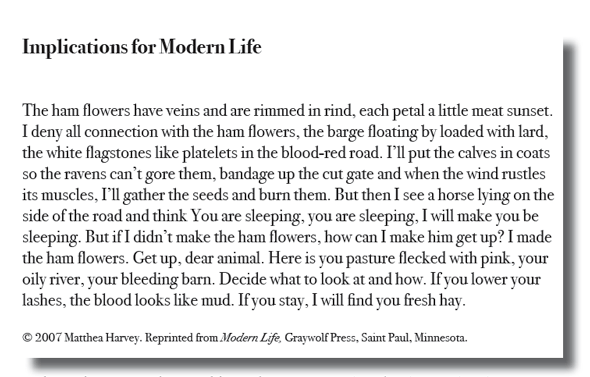
MH: Probably yes. Going to museums or galleries always makes me want to write. I love the imaginary worlds in the work of Amy Cutler, Marcel Dzama, and Julie Morstad, Rebecca Horn’s mechanical sculptures, the quiet in Agnes Martin’s paintings, Louise Bourgeois’s psychological drawings and sculptures, Tom Friedman’s miniatures, Gabriel Orozco’s clever photographs and Andrea Dezsö’s book art. Those are just a few…
WV: You’ve mentioned your admiration for the films of Hiyao Miyazaki. What other film makers/animators do you admire?
MH: Michel Gondry, Wes Anderson, Jean Painlevé (his more whimsical science films, excluding the psychologically scarring one I recently saw in which a vampire bat slowly drains a guinea pig of all its blood), Pedro Almodovar, Kimberly Peirce, Spike Jonze, Jane Campion, Sylvain Chomet (The Triplets of Belleville), Ang Lee, Sam Mendes, Joss Whedon, Miranda July and Werner Herzog.
WV: You went to college at Harvard & Iowa (MFA). What did you study as an undergrad? I’m especially wondering whether you had an interest in math—the math puns in poems like “You know this too” or the photograph you took for the Modern Life cover have made me curious about that.
MH: I studied English at Harvard and wrote a creative thesis (a collection of poems), with Henri Cole as my advisor. I am still attached to my incredibly fat and thin-papered Norton Anthology of Literature. When I was little, apparently I wanted to be a math teacher (or a philosopher named Themistocpholes), but I have very little spatial understanding and doing calculus was like repeating the words to a language without knowing what they meant. Maybe that’s why nowadays I seem to be mostly interested in simple division—half cat, half goat or half robot, half boy. I like that dominoes look like they’re fractions—even when you’ve made the dots out of photographs of blackberries submerged in milk (the photograph I took for the cover of my last book Modern Life). I keep meaning to actually learn how to play dominoes.
WV: What poets have influenced your work? What contemporary poets do you enjoy reading?
MH: I’m very bad at identifying influence, but some of the greats I adore are Wallace Stevens, Emily Dickinson, Elizabeth Bishop, Henri Michaux, W. H. Auden, John Berryman…In terms of contemporary poets, I read anything and everything—Russell Edson, Tomas Tranströmer, Claudia Rankine, Anne Carson, Cathy Park Hong, Jen Bervin, Kay Ryan, Mary Ruefle, Timothy Donnelly, Brenda Shaughnessy, Terrence Hayes, Lisa Jarnot…
WV: I think of your poetry as imaginative, whimsical, witty, mysterious, cerebral, and distant or private. Do you make the conscious decision to avoid the personal?
MH: No—it just seems to happen. I guess I’m a bit of a projector—my emotions tend to get translated into different, fanciful situations. I did recently write one very straightforward poem, but I’m not sure it’s any good. I’ll have to sit with it for a while. I don’t find the “autobiographical me” very interesting—I work much more from my ideas than from my actual experiences. On the other hand, I’m often enthralled by other people’s “I’s.”
WV: Do you see your work as related to a tradition of American women poets or not? If you were teaching yourself to students, who else would you include in the course?
MH: Let’s hope I never teach myself to my students! I’m certainly an American woman poet, and many of my favorite writers are from that group, but it’s such a large category, I’m not sure it means that much. Umbrellas always miss an elbow or a knee. I’d like to be on the syllabus for an interdisciplinary course which would include Tom Phillips’ A Hummument, artwork by Nina Katchadourian, Kara Walker and Hannah Höch, fiction by Kelly Link, Aimee Bender, Lydia Davis and Etgar Keret, nonfiction by Anne Fadiman, and graphic novels by Shaun Tan, Paul Hornschemeier, Chris Ware and Gabrielle Bell.
WV: Poets like Billy Collins and Ted Kooser have made a conscious decision to write to an audience. What do you think about the notion of “accessible poetry”?
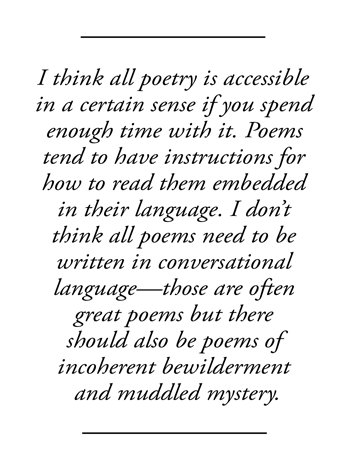
MH: I think all poetry is accessible in a certain sense if you spend enough time with it. Poems tend to have instructions for how to read them embedded in their language. I don’t think all poems need to be written in conversational language—those are often great poems but there should also be poems of incoherent bewilderment and muddled mystery.
WV: You’re an extremely funny, maybe grimly funny, poet. “The Future of Terror/6,” for example, is full of puns and logical non sequiturs. Could you tell me a little about the significance to you of humor in poetry? Do you make an effort to include humor in your poems?
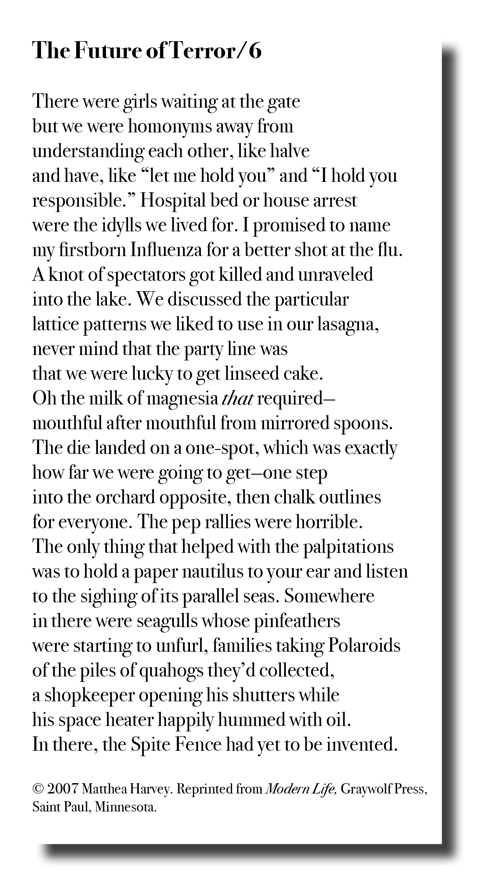
MH: No. I think that’s just my sensibility. I do it automatically. I think the humor tends to happen when I’m writing about darker subjects—if one hand plays the black keys the other hand jumps in to press the white keys.
WV: Although your work isn’t “formal” in a traditional sense, you clearly have an interest in form. “The Future of Terror” and “Terror of the Future” series in Modern Life take the abecedarium/ zebecedarium, a type of poem that Wisconsin poet Karl Elder (Gilgamesh at the Bellagio) has worked with extensively, but bend the rules considerably. What role does form play in your work?
MH: The “Future of Terror” and “Terror of the Future” series uses a modified abecedarian technique—moving alphabetically between the words terror and future (forwards and backwards). I love when form plots out a path you couldn’t have seen before—it’s like suddenly having to maneuver through a room full of laser beams—you’re suddenly doing a dance you couldn’t have invented without those restrictions. Usually form seems to find me in the process of writing a poem, though I have nothing against starting out with the form, as I did with a recent erasure. Erasures are exciting to me because they’re another way to let go. You have this one page of text and you have to find your poem in that selection of words. When I have my students do erasures, I’m always amazed by the way their voice comes through, whether they’re doing an erasure of a romance novel or an encyclopedia. Your sensibility will out. We humans have an amazing way of making everything personal.
WV: You’re a particularly skilled writer of the prose poem, and I love how that fits into your thematic program—half poem, half fiction. Do you view the prose poem as a form, and has it become more important to you than other kinds of poems? What, if anything, does it allow you to do that other forms don’t?
MH: I do love the prose poem because it’s such a perverse and provocative little box—always asking to be questioned, never giving a straight or definitive answer. I like how it gives a feeling of containment to the words within. It’s a form of sorts, but a pretty loose one. I let my narrative embroidering impulses take over in prose poems.
WV: Many of the poems in Modern Life could be characterized as science-fiction. Could you talk about your interest in that genre?
MH: Well, sci fi television shows like Battlestar Galactica and V seem to be on the upswing, and I’m all for it. Ditto for vampires. When I was younger, my sci fi interests tended towards Anne McCaffrey’s dragon series. One of my favorite contemporary sci fi novels is Jonathan Lethem’s Girl in Landscape, which I often assign to my poetry workshops. That book features creatures called Archbuilders who give themselves inspired names like Hiding Kneel, Truth Renowned, Gelatinous Stand and Lonely Dumptruck as well as little hard-to-see creatures called housedeer.
WV: What are you working on right now? Do you have an interest in hybrid forms?
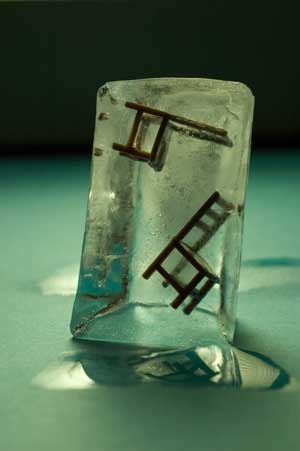 MH: The last few months I’ve been obsessed with taking photographs of miniatures inside of ice cubes. I think I’ve ended up with two series, each of which is titled with an ice cube containing a scrap of paper with text on it. One series is titled “Help” and features tiny people and animals trapped in ice cubes. The other, “Stay,” is a series of topsy-turvy chairs frozen into place. I think they may be some kind of ice poem rebuses. So yes, I am pretty interested in hybrid forms. I love graphic novels and I think there should be more graphic poems in the world. I’m also interested in concrete poems—anything that complicates the line between the written and the visual. Some of the poems I’m working on now have photographs as titles and others have cutout silhouette titles—so, for example, a poem called “My Octopus Orphan” is a silhouette of an octopus with those letters cut out of the silhouette. I’m also working on a book called Of Lamb, with the artist Amy Jean Porter. It’s an erasure of a Charles Lamb biography and Amy is doing these wild and independent drawings to go along with the words. I’m also working on designing a two-sided poster with the artist Adam Shecter for a project called 2UP, where artists and writers co-create a poster.
MH: The last few months I’ve been obsessed with taking photographs of miniatures inside of ice cubes. I think I’ve ended up with two series, each of which is titled with an ice cube containing a scrap of paper with text on it. One series is titled “Help” and features tiny people and animals trapped in ice cubes. The other, “Stay,” is a series of topsy-turvy chairs frozen into place. I think they may be some kind of ice poem rebuses. So yes, I am pretty interested in hybrid forms. I love graphic novels and I think there should be more graphic poems in the world. I’m also interested in concrete poems—anything that complicates the line between the written and the visual. Some of the poems I’m working on now have photographs as titles and others have cutout silhouette titles—so, for example, a poem called “My Octopus Orphan” is a silhouette of an octopus with those letters cut out of the silhouette. I’m also working on a book called Of Lamb, with the artist Amy Jean Porter. It’s an erasure of a Charles Lamb biography and Amy is doing these wild and independent drawings to go along with the words. I’m also working on designing a two-sided poster with the artist Adam Shecter for a project called 2UP, where artists and writers co-create a poster.
WV: What else do you do when you’re not writing or teaching?
MH: This fall I’ve been on a reading tear—three or four books a week. Recently I read Audrey Niffenegger’s Her Fearful Symmetry, four novels by Lionel Shriver, and the letters between Elizabeth Bishop and Robert Lowell. I’m taking my third photography class at the International Center for Photography, and loving it, though this week we are supposed to do self-portraits and I would rather pull out all my teeth. And lately, I’ve been planning a book party for The Little General and the Giant Snowflake. My illustrator and dear friend has made a giant stuffed lemming, which we’re going to raffle off, and I’m working on a lemming cocktail called a Lemming Fizz. Lastly, I’m trying to write a poem about a kangamouse, for a website called Underwater New York. You pick an item that has been found abandoned on a beach. I love the kangamouse—it’s pink and speckled with rust. It has only one ear and a little heart-light. The problem I’m having is that it’s already a poem without words.
Wendy Vardaman, author of Obstructed View (Fireweed Press 2009), is the co-editor of Verse Wisconsin. Visit wendyvardaman.com. Her review of Matthea Harvey's Modern Life is available online.


